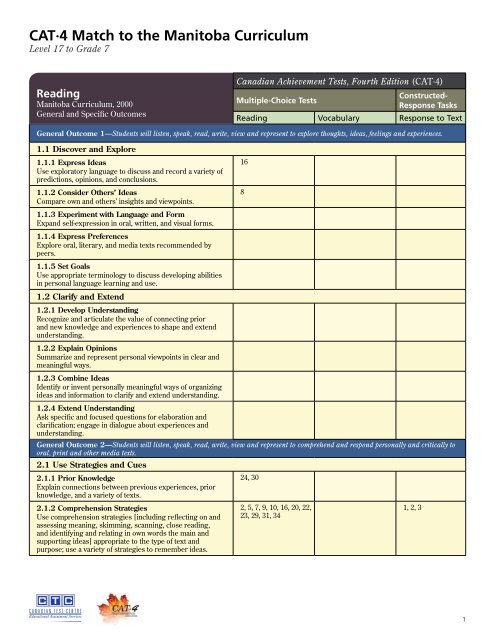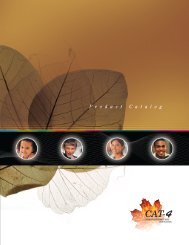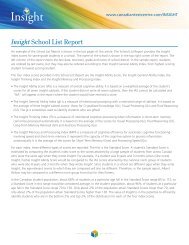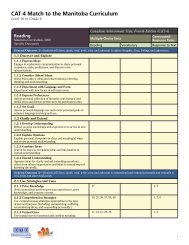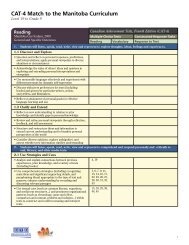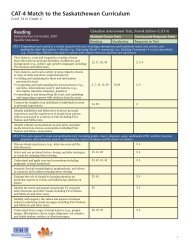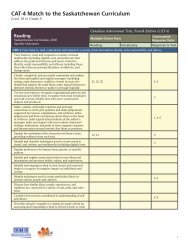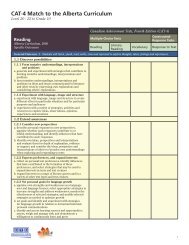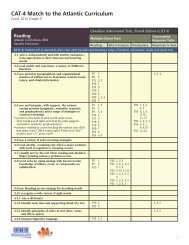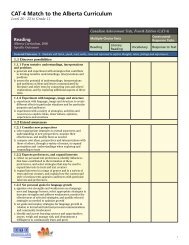CATâ4 Match to the Manitoba Curriculum - Canadian Test Centre
CATâ4 Match to the Manitoba Curriculum - Canadian Test Centre
CATâ4 Match to the Manitoba Curriculum - Canadian Test Centre
Create successful ePaper yourself
Turn your PDF publications into a flip-book with our unique Google optimized e-Paper software.
CAT∙4 <strong>Match</strong> <strong>to</strong> <strong>the</strong> Mani<strong>to</strong>ba <strong>Curriculum</strong><br />
Level 17 <strong>to</strong> Grade 7<br />
Reading<br />
Mani<strong>to</strong>ba <strong>Curriculum</strong>, 2000<br />
General and Specific Outcomes<br />
<strong>Canadian</strong> Achievement <strong>Test</strong>s, Fourth Edition (CAT·4)<br />
Multiple-Choice <strong>Test</strong>s<br />
Constructed-<br />
Response Tasks<br />
Reading Vocabulary Response <strong>to</strong> Text<br />
General Outcome 1—Students will listen, speak, read, write, view and represent <strong>to</strong> explore thoughts, ideas, feelings and experiences.<br />
1.1 Discover and Explore<br />
1.1.1 Express Ideas<br />
Use explora<strong>to</strong>ry language <strong>to</strong> discuss and record a variety of<br />
predictions, opinions, and conclusions.<br />
1.1.2 Consider O<strong>the</strong>rs’ Ideas<br />
Compare own and o<strong>the</strong>rs’ insights and viewpoints.<br />
1.1.3 Experiment with Language and Form<br />
Expand self-expression in oral, written, and visual forms.<br />
1.1.4 Express Preferences<br />
Explore oral, literary, and media texts recommended by<br />
peers.<br />
1.1.5 Set Goals<br />
Use appropriate terminology <strong>to</strong> discuss developing abilities<br />
in personal language learning and use.<br />
1.2 Clarify and Extend<br />
16<br />
8<br />
1.2.1 Develop Understanding<br />
Recognize and articulate <strong>the</strong> value of connecting prior<br />
and new knowledge and experiences <strong>to</strong> shape and extend<br />
understanding.<br />
1.2.2 Explain Opinions<br />
Summarize and represent personal viewpoints in clear and<br />
meaningful ways.<br />
1.2.3 Combine Ideas<br />
Identify or invent personally meaningful ways of organizing<br />
ideas and information <strong>to</strong> clarify and extend understanding.<br />
1.2.4 Extend Understanding<br />
Ask specific and focused questions for elaboration and<br />
clarification; engage in dialogue about experiences and<br />
understanding.<br />
General Outcome 2—Students will listen, speak, read, write, view and represent <strong>to</strong> comprehend and respond personally and critically <strong>to</strong><br />
oral, print and o<strong>the</strong>r media texts.<br />
2.1 Use Strategies and Cues<br />
2.1.1 Prior Knowledge<br />
Explain connections between previous experiences, prior<br />
knowledge, and a variety of texts.<br />
2.1.2 Comprehension Strategies<br />
Use comprehension strategies [including reflecting on and<br />
assessing meaning, skimming, scanning, close reading,<br />
and identifying and relating in own words <strong>the</strong> main and<br />
supporting ideas] appropriate <strong>to</strong> <strong>the</strong> type of text and<br />
purpose; use a variety of strategies <strong>to</strong> remember ideas.<br />
24, 30<br />
2, 5, 7, 9, 10, 16, 20, 22,<br />
23, 29, 31, 34<br />
1, 2, 3<br />
1
CAT∙4 <strong>Match</strong> <strong>to</strong> <strong>the</strong> Mani<strong>to</strong>ba <strong>Curriculum</strong><br />
Level 17 <strong>to</strong> Grade 7<br />
Reading<br />
Mani<strong>to</strong>ba <strong>Curriculum</strong>, 2000<br />
General and Specific Outcomes<br />
2.1.3 Textual Cues<br />
Use textual cues <strong>to</strong> construct and confirm meaning and<br />
interpret texts.<br />
2.1.4 Cueing Systems<br />
Use syntactic, semantic, and graphophonic cueing systems<br />
[including word order; context clues and multiple meanings<br />
of words; structural analysis <strong>to</strong> identify roots, prefixes, and<br />
suffixes] <strong>to</strong> construct and confirm meaning and interpret<br />
texts [including meaning of specialized vocabulary].<br />
2.2 Respond <strong>to</strong> Texts<br />
2.2.1 Experience Various Texts<br />
Experience texts from a variety of forms and genres and<br />
cultural traditions; discuss likes and dislikes.<br />
2.2.2 Connect Self, Texts, and Culture<br />
Compare own with o<strong>the</strong>rs’ understanding of people, cultural<br />
traditions, and values portrayed in oral, literary, and media<br />
texts [including texts about Canada or by <strong>Canadian</strong> writers].<br />
2.2.3 Appreciate <strong>the</strong> Artistry of Texts<br />
Identify language and visual images that create mood and<br />
evoke emotion in oral, literary, and media texts.<br />
2.3 Understand Forms and Techniques<br />
2.3.1 Forms and Genre<br />
Explain preferences for particular forms and genres of oral,<br />
literary, and media texts<br />
2.3.2 Techniques and Elements<br />
Examine techniques of plot development and of persuasion<br />
in oral, literary, and media texts.<br />
2.3.3 Vocabulary<br />
Recognize uses and abuses of slang, colloquialism, and<br />
jargon.<br />
2.3.4 Experiment with Language<br />
Identify surprising and playful uses of language in oral,<br />
literary, and media texts; explain ways in which figures of<br />
speech convey meaning.<br />
2.3.5 Create Original Texts<br />
Create original texts <strong>to</strong> communicate and demonstrate<br />
understanding of forms and techniques.<br />
<strong>Canadian</strong> Achievement <strong>Test</strong>s, Fourth Edition (CAT·4)<br />
Multiple-Choice <strong>Test</strong>s<br />
Constructed-<br />
Response Tasks<br />
Reading Vocabulary Response <strong>to</strong> Text<br />
1, 18, 19, 21, 25, 32, 35 1, 4, 6<br />
4, 36, 38 3, 4<br />
3, 4, 5<br />
37, 39, 40 3, 5<br />
6, 12 3, 5<br />
General Outcome 3—Students will listen, speak, read, write, view and represent <strong>to</strong> manage ideas and information.<br />
3.1 Plan and Focus<br />
3.1.1 Use Personal Knowledge<br />
Examine personal knowledge of and experiences related <strong>to</strong><br />
a <strong>to</strong>pic <strong>to</strong> determine information needs.<br />
2<br />
2
CAT∙4 <strong>Match</strong> <strong>to</strong> <strong>the</strong> Mani<strong>to</strong>ba <strong>Curriculum</strong><br />
Level 17 <strong>to</strong> Grade 7<br />
Reading<br />
Mani<strong>to</strong>ba <strong>Curriculum</strong>, 2000<br />
General and Specific Outcomes<br />
3.1.2 Ask Questions<br />
Formulate a variety of relevant questions on a <strong>to</strong>pic <strong>to</strong><br />
establish a purpose for seeking information.<br />
3.1.3 Contribute <strong>to</strong> Group Inquiry<br />
Contribute ideas, knowledge, and questions <strong>to</strong> help<br />
establish group inquiry or research focuses and purposes.<br />
3.1.4 Create and Follow a Plan<br />
Prepare and use a plan <strong>to</strong> access information and ideas from<br />
a variety of sources.<br />
3.2 Select and Process<br />
3.2.1 Identify Personal and Peer Knowledge<br />
Select and organize personal and peer knowledge of a <strong>to</strong>pic<br />
<strong>to</strong> establish an information base for inquiry or research.<br />
3.2.2 Identify Sources<br />
Extend inquiry and research questions using a variety of<br />
information sources.<br />
3.2.3 Assess Sources<br />
Use pre-established criteria <strong>to</strong> evaluate <strong>the</strong> currency,<br />
usefulness, and reliability of information sources in<br />
answering inquiry or research questions.<br />
3.2.4 Access Information<br />
Expand and use a reper<strong>to</strong>ire of skills [including visual and<br />
audi<strong>to</strong>ry] <strong>to</strong> access information and ideas from a variety of<br />
sources [including formal interviews, surveys, almanacs,<br />
documentaries, and broadcasts].<br />
3.2.5 Make Sense of Information<br />
Determine literal and implied meaning of oral, visual,<br />
and written texts using a variety of strategies and cues<br />
[including headings, subheadings, <strong>to</strong>pic sentences,<br />
summaries, camera angle, staging and pacing, and<br />
screening out irrelevant information].<br />
3.3 Organize, Record, and Assess<br />
3.3.1 Organize Information<br />
Organize information and ideas by selecting or developing<br />
categories appropriate <strong>to</strong> a particular <strong>to</strong>pic and purpose.<br />
3.3.2 Record Information<br />
Make notes using headings and sub-headings or graphic<br />
organizers appropriate <strong>to</strong> a <strong>to</strong>pic; reference sources.<br />
3.3.3 Evaluate Information<br />
Assess <strong>the</strong> appropriateness of <strong>the</strong> amount and quality of<br />
information collected; recognize and address information<br />
gaps for particular forms, audiences, and purposes.<br />
3.3.4 Develop New Understanding<br />
Organize new information and connect it <strong>to</strong> prior<br />
knowledge; reflect on <strong>the</strong> impact of new information on <strong>the</strong><br />
inquiry or research process.<br />
<strong>Canadian</strong> Achievement <strong>Test</strong>s, Fourth Edition (CAT·4)<br />
Multiple-Choice <strong>Test</strong>s<br />
Constructed-<br />
Response Tasks<br />
Reading Vocabulary Response <strong>to</strong> Text<br />
3, 4<br />
1, 3, 15, 17, 26 5, 6<br />
27 4<br />
1<br />
2, 3, 6<br />
3
CAT∙4 <strong>Match</strong> <strong>to</strong> <strong>the</strong> Mani<strong>to</strong>ba <strong>Curriculum</strong><br />
Level 17 <strong>to</strong> Grade 7<br />
Reading<br />
Mani<strong>to</strong>ba <strong>Curriculum</strong>, 2000<br />
General and Specific Outcomes<br />
<strong>Canadian</strong> Achievement <strong>Test</strong>s, Fourth Edition (CAT·4)<br />
Multiple-Choice <strong>Test</strong>s<br />
Constructed-<br />
Response Tasks<br />
Reading Vocabulary Response <strong>to</strong> Text<br />
General Outcome 4—Students will listen, speak, read, write, view and represent <strong>to</strong> enhance <strong>the</strong> clarity and artistry of communication.<br />
4.1 Generate and Focus<br />
4.1.1 Generate Ideas<br />
Consider form and audience when generating ideas and<br />
focusing a <strong>to</strong>pic.<br />
4.1.2 Choose Forms<br />
Select and compose using specific forms that serve various<br />
audiences and purposes.<br />
4.1.3 Organize Ideas<br />
Identify and use appropriate organizational patterns that<br />
serve various audiences and purposes.<br />
4.2 Enhance and Improve<br />
4.2.1 Appraise Own and O<strong>the</strong>rs’ Work<br />
Appraise and suggest revisions for own and o<strong>the</strong>rs’ work<br />
and presentations using appropriate criteria and a variety of<br />
strategies.<br />
4.2.2 Revise Content<br />
Revise <strong>to</strong> create effective sentences that convey content<br />
clearly and generate reader interest.<br />
4.2.3 Enhance Legibility<br />
Determine <strong>the</strong> appropriateness of handwriting or word<br />
processing for a particular task when composing, formatting,<br />
and revising; combine print and visuals when desk<strong>to</strong>p<br />
publishing.<br />
4.2.4 Enhance Artistry<br />
Experiment with figures of speech [including similes,<br />
metaphors, and personification], selecting appropriate<br />
words and sentence patterns during revision <strong>to</strong> enhance<br />
clarity and artistry.<br />
4.2.5 Enhance Presentation<br />
Prepare compositions, reports, and inquiry or research<br />
projects using a variety of organizers.<br />
4.3 Attend <strong>to</strong> Conventions<br />
4.3.1 Grammar and Usage<br />
Edit for consistent verb tense and <strong>to</strong> eliminate unnecessary<br />
repetition of words and ideas.<br />
4.3.2 Spelling (see Strategies)<br />
Know spelling conventions and apply <strong>the</strong>m <strong>to</strong> familiar and<br />
unfamiliar words; use appropriate resources when editing<br />
and proofreading.<br />
4.3.3 Punctuation and Capitalization<br />
Know and apply capitalization and punctuation conventions<br />
in simple, compound, and complex sentences when editing<br />
and proofreading.<br />
14<br />
3, 11, 28<br />
4
CAT∙4 <strong>Match</strong> <strong>to</strong> <strong>the</strong> Mani<strong>to</strong>ba <strong>Curriculum</strong><br />
Level 17 <strong>to</strong> Grade 7<br />
Reading<br />
Mani<strong>to</strong>ba <strong>Curriculum</strong>, 2000<br />
General and Specific Outcomes<br />
4.4 Present and Share<br />
4.4.1 Share Ideas and Information<br />
Facilitate small-group activities and short, whole-class<br />
sessions <strong>to</strong> share information on a <strong>to</strong>pic using preestablished<br />
active learning strategies.<br />
4.4.2 Effective Oral Communication<br />
Deliver short oral presentations and reports using verbal<br />
and non-verbal cues <strong>to</strong> focus audience attention; project<br />
emotion appropriate <strong>to</strong> <strong>the</strong> subject and point of view.<br />
4.4.3 Attentive Listening and Viewing<br />
Demonstrate critical listening and viewing skills and<br />
strategies and show respect for presenter(s) through<br />
appropriate audience behaviours.<br />
<strong>Canadian</strong> Achievement <strong>Test</strong>s, Fourth Edition (CAT·4)<br />
Multiple-Choice <strong>Test</strong>s<br />
Constructed-<br />
Response Tasks<br />
Reading Vocabulary Response <strong>to</strong> Text<br />
5
CAT∙4 <strong>Match</strong> <strong>to</strong> <strong>the</strong> Mani<strong>to</strong>ba <strong>Curriculum</strong><br />
Level 17 <strong>to</strong> Grade 7<br />
Writing<br />
Mani<strong>to</strong>ba <strong>Curriculum</strong>, 2000<br />
General and Specific Outcomes<br />
<strong>Canadian</strong> Achievement <strong>Test</strong>s, Fourth Edition (CAT·4)<br />
Multiple-Choice <strong>Test</strong>s<br />
Writing<br />
Spelling<br />
Conventions<br />
Constructed-Response Tasks<br />
Writing<br />
General Outcome 2—Students will listen, speak, read, write, view and represent <strong>to</strong> comprehend and respond personally and critically <strong>to</strong><br />
oral, print and o<strong>the</strong>r media texts.<br />
2.1 Use Strategies and Cues<br />
2.1.1 Prior Knowledge<br />
Explain connections between previous experiences, prior<br />
knowledge, and a variety of texts.<br />
2.1.2 Comprehension Strategies<br />
Use comprehension strategies [including reflecting on and<br />
assessing meaning, skimming, scanning, close reading,<br />
and identifying and relating in own words <strong>the</strong> main and<br />
supporting ideas] appropriate <strong>to</strong> <strong>the</strong> type of text and<br />
purpose; use a variety of strategies <strong>to</strong> remember ideas.<br />
2.1.3 Textual Cues<br />
Use textual cues <strong>to</strong> construct and confirm meaning and<br />
interpret texts.<br />
2.1.4 Cueing Systems<br />
Use syntactic, semantic, and graphophonic cueing systems<br />
[including word order; context clues and multiple meanings<br />
of words; structural analysis <strong>to</strong> identify roots, prefixes, and<br />
suffixes] <strong>to</strong> construct and confirm meaning and interpret<br />
texts [including meaning of specialized vocabulary].<br />
2.2 Respond <strong>to</strong> Texts<br />
2.2.1 Experience Various Texts<br />
Experience texts from a variety of forms and genres and<br />
cultural traditions; discuss likes and dislikes.<br />
2.2.2 Connect Self, Texts, and Culture<br />
Compare own with o<strong>the</strong>rs’ understanding of people, cultural<br />
traditions, and values portrayed in oral, literary, and media<br />
texts [including texts about Canada or by <strong>Canadian</strong> writers].<br />
2.2.3 Appreciate <strong>the</strong> Artistry of Texts<br />
Identify language and visual images that create mood and<br />
evoke emotion in oral, literary, and media texts.<br />
2.3 Understand forms and genres<br />
2.3.1 Forms and Genre<br />
Explain preferences for particular forms and genres of oral,<br />
literary, and media texts<br />
2.3.2 Techniques and Elements<br />
Examine techniques of plot development and of persuasion<br />
in oral, literary, and media texts.<br />
2.3.3 Vocabulary<br />
Recognize uses and abuses of slang, colloquialism, and<br />
jargon.<br />
2.3.4 Experiment with Language<br />
Identify surprising and playful uses of language in oral,<br />
literary, and media texts; explain ways in which figures of<br />
speech convey meaning.<br />
17, 18, 19, 20,<br />
21, 22<br />
6
CAT∙4 <strong>Match</strong> <strong>to</strong> <strong>the</strong> Mani<strong>to</strong>ba <strong>Curriculum</strong><br />
Level 17 <strong>to</strong> Grade 7<br />
Writing<br />
Mani<strong>to</strong>ba <strong>Curriculum</strong>, 2000<br />
General and Specific Outcomes<br />
2.3.5 Create Original Texts<br />
Create original texts <strong>to</strong> communicate and demonstrate<br />
understanding of forms and techniques.<br />
<strong>Canadian</strong> Achievement <strong>Test</strong>s, Fourth Edition (CAT·4)<br />
Multiple-Choice <strong>Test</strong>s<br />
Writing<br />
Spelling<br />
Conventions<br />
Constructed-Response Tasks<br />
Writing<br />
1, 2, 3, 4, 5<br />
General Outcome 3—Students will listen, speak, read, write, view and represent <strong>to</strong> manage ideas and information.<br />
3.1 Plan and Focus<br />
3.1.1 Use Personal Knowledge<br />
Examine personal knowledge of and experiences related <strong>to</strong><br />
a <strong>to</strong>pic <strong>to</strong> determine information needs.<br />
3.1.2 Ask Questions<br />
Formulate a variety of relevant questions on a <strong>to</strong>pic <strong>to</strong><br />
establish a purpose for seeking information.<br />
3.1.3 Contribute <strong>to</strong> Group Inquiry<br />
Contribute ideas, knowledge, and questions <strong>to</strong> help<br />
establish group inquiry or research focuses and purposes.<br />
3.1.4 Create and Follow a Plan<br />
Prepare and use a plan <strong>to</strong> access information and ideas from<br />
a variety of sources.<br />
3.2 Select and Process<br />
3.2.1 Identify Personal and Peer Knowledge<br />
Select and organize personal and peer knowledge of a <strong>to</strong>pic<br />
<strong>to</strong> establish an information base for inquiry or research.<br />
3.2.2 Identify Sources<br />
Extend inquiry and research questions using a variety of<br />
information sources.<br />
3.2.3 Assess Sources<br />
Use pre-established criteria <strong>to</strong> evaluate <strong>the</strong> currency,<br />
usefulness, and reliability of information sources in<br />
answering inquiry or research questions.<br />
3.2.4 Access Information<br />
Expand and use a reper<strong>to</strong>ire of skills [including visual and<br />
audi<strong>to</strong>ry] <strong>to</strong> access information and ideas from a variety of<br />
sources [including formal interviews, surveys, almanacs,<br />
documentaries, and broadcasts].<br />
3.2.5 Make Sense of Information<br />
Determine literal and implied meaning of oral, visual,<br />
and written texts using a variety of strategies and cues<br />
[including headings, subheadings, <strong>to</strong>pic sentences,<br />
summaries, camera angle, staging and pacing, and<br />
screening out irrelevant information].<br />
3.3 Organize, Record and Evaluate<br />
3.3.1 Organize Information<br />
Organize information and ideas by selecting or developing<br />
categories appropriate <strong>to</strong> a particular <strong>to</strong>pic and purpose.<br />
3.3.2 Record Information<br />
Make notes using headings and sub-headings or graphic<br />
organizers appropriate <strong>to</strong> a <strong>to</strong>pic; reference sources.<br />
7
CAT∙4 <strong>Match</strong> <strong>to</strong> <strong>the</strong> Mani<strong>to</strong>ba <strong>Curriculum</strong><br />
Level 17 <strong>to</strong> Grade 7<br />
Writing<br />
Mani<strong>to</strong>ba <strong>Curriculum</strong>, 2000<br />
General and Specific Outcomes<br />
3.3.3 Evaluate Information<br />
Assess <strong>the</strong> appropriateness of <strong>the</strong> amount and quality of<br />
information collected; recognize and address information<br />
gaps for particular forms, audiences, and purposes.<br />
3.3.4 Develop New Understanding<br />
Organize new information and connect it <strong>to</strong> prior<br />
knowledge; reflect on <strong>the</strong> impact of new information on <strong>the</strong><br />
inquiry or research process.<br />
<strong>Canadian</strong> Achievement <strong>Test</strong>s, Fourth Edition (CAT·4)<br />
Multiple-Choice <strong>Test</strong>s<br />
Writing<br />
Spelling<br />
Conventions<br />
Constructed-Response Tasks<br />
Writing<br />
General Outcome 4—Students will listen, speak, read, write, view and represent <strong>to</strong> enhance <strong>the</strong> clarity and artistry of communication.<br />
4.1 Generate and Focus<br />
4.1.1 Generate Ideas<br />
2, 3, 5<br />
Consider form and audience when generating ideas and<br />
focusing a <strong>to</strong>pic.<br />
4.1.2 Choose Forms<br />
3, 5<br />
Select and compose using specific forms that serve various<br />
audiences and purposes.<br />
4.1.3 Organize Ideas<br />
Identify and use appropriate organizational patterns that<br />
serve various audiences and purposes.<br />
37, 38, 39, 40 1, 3, 5<br />
4.2 Enhance and Improve<br />
4.2.1 Appraise Own and O<strong>the</strong>rs’ Work<br />
Appraise and suggest revisions for own and o<strong>the</strong>rs’ work<br />
and presentations using appropriate criteria and a variety of<br />
strategies.<br />
4.2.2 Revise Content<br />
Revise <strong>to</strong> create effective sentences that convey content<br />
clearly and generate reader interest.<br />
4.2.3 Enhance Legibility<br />
Determine <strong>the</strong> appropriateness of handwriting or word<br />
processing for a particular task when composing,<br />
formatting, and revising; combine print and visuals when<br />
desk<strong>to</strong>p publishing.<br />
4.2.4 Enhance Artistry<br />
Experiment with figures of speech [including similes,<br />
metaphors, and personification], selecting appropriate<br />
words and sentence patterns during revision <strong>to</strong> enhance<br />
clarity and artistry.<br />
4.2.5 Enhance Presentation<br />
Prepare compositions, reports, and inquiry or research<br />
projects using a variety of organizers.<br />
4.3 Attend <strong>to</strong> Conventions<br />
4.3.1 Grammar and Usage<br />
Edit for consistent verb tense and <strong>to</strong> eliminate unnecessary<br />
repetition of words and ideas.<br />
30, 31, 34, 35<br />
23, 24, 25, 26,<br />
27, 28<br />
1, 2, 3, 4, 5<br />
29, 32, 33, 36 1, 2, 3, 4, 5<br />
4<br />
3<br />
8
CAT∙4 <strong>Match</strong> <strong>to</strong> <strong>the</strong> Mani<strong>to</strong>ba <strong>Curriculum</strong><br />
Level 17 <strong>to</strong> Grade 7<br />
Writing<br />
Mani<strong>to</strong>ba <strong>Curriculum</strong>, 2000<br />
General and Specific Outcomes<br />
4.3.2 Spelling (see Strategies)<br />
Know spelling conventions and apply <strong>the</strong>m <strong>to</strong> familiar and<br />
unfamiliar words; use appropriate resources when editing<br />
and proofreading.<br />
4.3.3 Punctuation and Capitalization<br />
Know and apply capitalization and punctuation conventions<br />
in simple, compound, and complex sentences when editing<br />
and proofreading.<br />
4.4 Present and Share<br />
4.4.1 Share Ideas and Information<br />
Share information on a <strong>to</strong>pic with class members in a<br />
planned and focused group session using a variety of<br />
strategies.<br />
4.4.2 Effective Oral Communication<br />
Use appropriate volume, phrasing, in<strong>to</strong>nation, non-verbal<br />
cues, and presentation space <strong>to</strong> enhance communication.<br />
4.4.3 Attentive Listening and Viewing<br />
Demonstrate critical listening and viewing skills and<br />
strategies and show respect for presenter(s) through<br />
appropriate audience behaviours.<br />
<strong>Canadian</strong> Achievement <strong>Test</strong>s, Fourth Edition (CAT·4)<br />
Multiple-Choice <strong>Test</strong>s<br />
Writing<br />
Spelling<br />
Conventions<br />
1, 2, 3, 4, 5, 6,<br />
7, 8, 9, 10, 11,<br />
12, 13, 14, 15,<br />
16, 17, 18, 19,<br />
20, 21, 22, 23,<br />
24, 25, 26, 27,<br />
28, 29, 30<br />
1, 2, 3, 4, 5,<br />
6, 7, 8, 9, 10,<br />
11, 12, 13, 14,<br />
15, 16<br />
Constructed-Response Tasks<br />
Writing<br />
1, 2, 3, 4, 5<br />
1, 2, 3, 4, 5<br />
General Outcome 5—Students will listen, speak, read, write, view, and represent <strong>to</strong> celebrate and <strong>to</strong> build community.<br />
5.1 Develop and Celebrate Community<br />
5.1.1 Compare Responses<br />
Demonstrate growing self-confidence when expressing and<br />
sharing thoughts, ideas and feelings.<br />
5.1.2 Relate Texts <strong>to</strong> Culture<br />
Compare ways in which oral, literary, and media texts from<br />
a variety of cultures explore similar ideas.<br />
5.1.3 Appreciate Diversity<br />
Compare <strong>the</strong> choices and behaviours of individuals<br />
presented in oral, literary and media texts with personal<br />
choices, values, and behaviours; discuss personal<br />
participation in communities in relation <strong>to</strong> past, present and<br />
future.<br />
5.1.4 Celebrate Special Occasions<br />
Select and use <strong>the</strong> language form and style appropriate<br />
for specific audiences <strong>to</strong> celebrate special events and<br />
accomplishments.<br />
5.2 Encourage, Support, and Work with O<strong>the</strong>rs<br />
5.2.1 Cooperate with O<strong>the</strong>rs<br />
Contribute <strong>to</strong> group efforts <strong>to</strong> reach consensus or<br />
conclusions.<br />
9
CAT∙4 <strong>Match</strong> <strong>to</strong> <strong>the</strong> Mani<strong>to</strong>ba <strong>Curriculum</strong><br />
Level 17 <strong>to</strong> Grade 7<br />
Writing<br />
Mani<strong>to</strong>ba <strong>Curriculum</strong>, 2000<br />
General and Specific Outcomes<br />
5.2.2 Work in Groups<br />
Present group conclusions or findings <strong>to</strong> classmates.<br />
5.2.3 Use Language <strong>to</strong> Show Respect<br />
Respect diverse languages, ideas, texts, and traditions,<br />
and recognize contributions of self, peers, and <strong>the</strong> wider<br />
community.<br />
5.2.4 Evaluate Group Process<br />
Evaluate group process and personal contributions<br />
according <strong>to</strong> pre-established criteria; set group and<br />
individual goals and record action plan.<br />
<strong>Canadian</strong> Achievement <strong>Test</strong>s, Fourth Edition (CAT·4)<br />
Multiple-Choice <strong>Test</strong>s<br />
Writing<br />
Spelling<br />
Conventions<br />
Constructed-Response Tasks<br />
Writing<br />
10
CAT∙4 <strong>Match</strong> <strong>to</strong> <strong>the</strong> Mani<strong>to</strong>ba <strong>Curriculum</strong><br />
Level 17 <strong>to</strong> Grade 7<br />
Ma<strong>the</strong>matics<br />
Mani<strong>to</strong>ba <strong>Curriculum</strong><br />
Specific Expectations<br />
Number Sense<br />
7.N.1. Determine and explain why a number is divisible by<br />
2, 3, 4, 5, 6, 8, 9, or 10, and why a number cannot be<br />
divided by 0.<br />
7.N.2. Demonstrate an understanding of <strong>the</strong> addition,<br />
subtraction, multiplication, and division of decimals<br />
<strong>to</strong> solve problems (for more than 1-digit divisors or<br />
2-digit multipliers, <strong>the</strong> use of technology is expected.)<br />
<strong>Canadian</strong> Achievement <strong>Test</strong>s, Fourth Edition (CAT·4)<br />
Multiple-Choice <strong>Test</strong>s<br />
Computation<br />
Ma<strong>the</strong>matics<br />
and Estimation<br />
2 1, 6, 12, 14, 20,<br />
21, 23, 26, 30, 36<br />
7.N.3. Solve problems involving percents from 1% <strong>to</strong> 100%. 1, 36, 55, 60 8, 22, 29, 31, 32<br />
7.N.4. Demonstrate an understanding of <strong>the</strong> relationship<br />
between repeating decimals and fractions, and<br />
terminating decimals and fractions.<br />
7.N.5. Demonstrate an understanding of adding and<br />
subtracting positive fractions and mixed numbers,<br />
with like and unlike denomina<strong>to</strong>rs, concretely,<br />
pic<strong>to</strong>rially, and symbolically (limited <strong>to</strong> positive sums<br />
and differences).<br />
7.N.6. Demonstrate an understanding of addition and<br />
subtraction of integers<br />
7.N.7. Compare and order fractions 15, 32, 46<br />
50 25, 27<br />
17, 18, 28, 34<br />
Foundational Skills<br />
Operations and problem solving with whole numbers 13, 34, 43, 44 2, 3, 4, 5, 7, 9, 10,<br />
11, 13, 15, 16, 19,<br />
24, 33, 35<br />
Constructed-Response Tasks<br />
Math Processes<br />
Strand: Patterns and Relations<br />
7.PR.1. Demonstrate an understanding of oral and written<br />
patterns and <strong>the</strong>ir equivalent relations.<br />
7.PR.2. Construct a table of values from a relation, graph<br />
<strong>the</strong> table of values, and analyze <strong>the</strong> graph <strong>to</strong> draw<br />
conclusions and solve problems.<br />
7.PR.3. Demonstrate an understanding of preservation of<br />
equality by:<br />
• modelling preservation of equality, concretely,<br />
pic<strong>to</strong>rially, and symbolically<br />
• applying preservation of equality <strong>to</strong> solve<br />
equations.<br />
7.PR.4. Explain <strong>the</strong> difference between an expression and an<br />
equation.<br />
7.PR.5. Evaluate an expression given <strong>the</strong> value of <strong>the</strong><br />
variable(s).<br />
7.PR.6. Model and solve problems that can be represented<br />
by one-step linear equations of <strong>the</strong> form x + a = b,<br />
concretely, pic<strong>to</strong>rially, symbolically, where a and b<br />
are integers.<br />
3, 6, 7, 17<br />
4, 39<br />
5, 8, 23, 25, 28<br />
11
CAT∙4 <strong>Match</strong> <strong>to</strong> <strong>the</strong> Mani<strong>to</strong>ba <strong>Curriculum</strong><br />
Level 17 <strong>to</strong> Grade 7<br />
Ma<strong>the</strong>matics<br />
Mani<strong>to</strong>ba <strong>Curriculum</strong><br />
Specific Expectations<br />
7.PR.7. Model and solve problems that can be represented<br />
by linear equations of <strong>the</strong> form:<br />
• ax + b = c<br />
• ax = b<br />
• ax = b, a ≠ 0 concretely, pic<strong>to</strong>rially, and<br />
symbolically, where a, b, and c are whole numbers.<br />
Strand: Shape and Space<br />
7.SS.1. Demonstrate an understanding of circles by:<br />
• describing <strong>the</strong> relationships among radius,<br />
diameter, and circumference of circles<br />
• relating circumference <strong>to</strong> pi<br />
• determining <strong>the</strong> sum of <strong>the</strong> central angles<br />
• constructing circles with a given Radius or<br />
diameter § solving problems involving <strong>the</strong> radii,<br />
diameters and /or circumferences of circles.<br />
7.SS.2. Develop and apply a formula for determining <strong>the</strong><br />
area of:<br />
• triangles<br />
• parallelograms<br />
• circles.<br />
7.SS.3. Perform geometric constructions, including<br />
• perpendicular line segments<br />
• parallel line segments<br />
• perpendicular bisec<strong>to</strong>rs<br />
• angle bisec<strong>to</strong>rs.<br />
7.SS.4. Perform and describe transformations of a 2-D shape<br />
in all four quadrants of a Cartesian plane (limited <strong>to</strong><br />
integral number vertices).<br />
<strong>Canadian</strong> Achievement <strong>Test</strong>s, Fourth Edition (CAT·4)<br />
Multiple-Choice <strong>Test</strong>s<br />
Computation<br />
Ma<strong>the</strong>matics<br />
and Estimation<br />
22<br />
29, 30, 33, 35,<br />
40, 51, 57, 58,<br />
59<br />
16, 42<br />
20, 24<br />
Foundational Skills<br />
Demonstrate an understanding of 2-D shapes 11, 41, 52, 56<br />
Demonstrate an understanding of 3-D figures 12, 18, 19, 27,<br />
31, 38, 45<br />
Strand: Statistics and Probability<br />
7.SP.1. Demonstrate an understanding of central tendency 9, 37, 53<br />
and range by<br />
• determining <strong>the</strong> measures of central tendency<br />
(mean, median, mode) and range<br />
• determining <strong>the</strong> most appropriate measures of<br />
central tendency <strong>to</strong> report findings.<br />
7.SP.2. Determine <strong>the</strong> effect on <strong>the</strong> mean, median, and mode 10<br />
when an outlier is included in a data set.<br />
7.SP.3. Construct, label, and interpret circle graphs <strong>to</strong> solve 21, 49<br />
problems.<br />
7.SP.4. Express probabilities as ratios, fractions, and<br />
21, 49<br />
percents.<br />
Constructed-Response Tasks<br />
Math Processes<br />
12
CAT∙4 <strong>Match</strong> <strong>to</strong> <strong>the</strong> Mani<strong>to</strong>ba <strong>Curriculum</strong><br />
Level 17 <strong>to</strong> Grade 7<br />
Ma<strong>the</strong>matics<br />
Mani<strong>to</strong>ba <strong>Curriculum</strong><br />
Specific Expectations<br />
7.SP.5. Identify <strong>the</strong> sample space (where <strong>the</strong> combined<br />
sample space has 36 or fewer elements) for a<br />
probability experiment involving two independent<br />
events.<br />
7.SP.6. Conduct a probability experiment <strong>to</strong> compare <strong>the</strong><br />
<strong>the</strong>oretical probability (determined using a tree<br />
diagram, table, or ano<strong>the</strong>r graphic organizer) and<br />
experimental probability of two independent events.<br />
Foundational Skills<br />
Analyze and Interpret data presented in tables and<br />
graphs<br />
<strong>Canadian</strong> Achievement <strong>Test</strong>s, Fourth Edition (CAT·4)<br />
Multiple-Choice <strong>Test</strong>s<br />
Computation<br />
Ma<strong>the</strong>matics<br />
and Estimation<br />
14, 26, 47, 48,<br />
54<br />
Constructed-Response Tasks<br />
Math Processes<br />
13


